-
Feed Chickens This for Super Healthy Eggs!
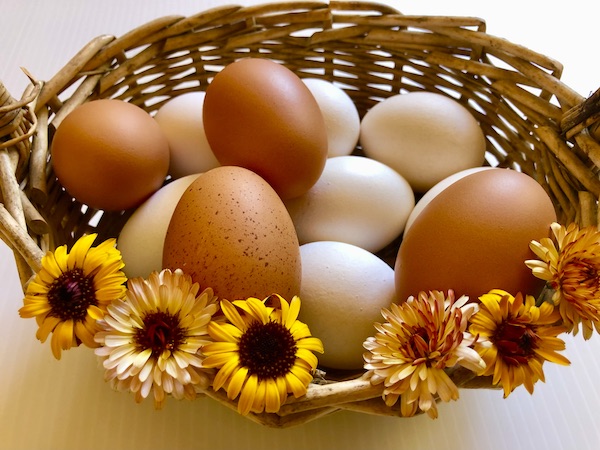
I was recently reading a story about a local couple here in California who are selling their designer eggs to upscale restaurants for $20.00 a dozen. Apparently they feed their chickens superfoods such as acerola cherry and camu camu powders (I had to look these up!) and give them coconut water to drink. While I am in awe that someone would go to such lengths to have healthy chickens and eggs, the truth is, it simply isn’t necessary. You don’t need fancy products to get healthy eggs. Here’s what to feed your chickens to ensure their eggs are as healthy as possible.
Free Range Them
The number one thing you can do to promote healthy egg laying is free range your chickens, which allows them to forage for insects, grains, and grasses. Chickens are natural foragers. But if you simply can’t due to the threat of predators, etc. here’s what you should feed your chickens.
Fresh Water
Access to fresh clean water is the number one thing chickens need to produce healthy eggs. Did you now that an egg is actually half water? Water is incredibly important or your chickens will become dehydrated and your egg production will plummet.
Protein
Insects are high in protein and your chickens will go gaga over them. You can give them worms or bugs from your garden or purchase mealy worms or crickets for them. Mine just loved the grubs I found when splitting wood from a dead tree on the farm. You can also give them cooked eggs, never raw. My chickens love both boiled and scrambled eggs. I also grow wheatgrass from seed as this has a high protein content and my chickens find it very tasty. Grass hay mixed with alfalfa, something I give my goats, I also give my chickens as it adds needed protein for healthy eggs.
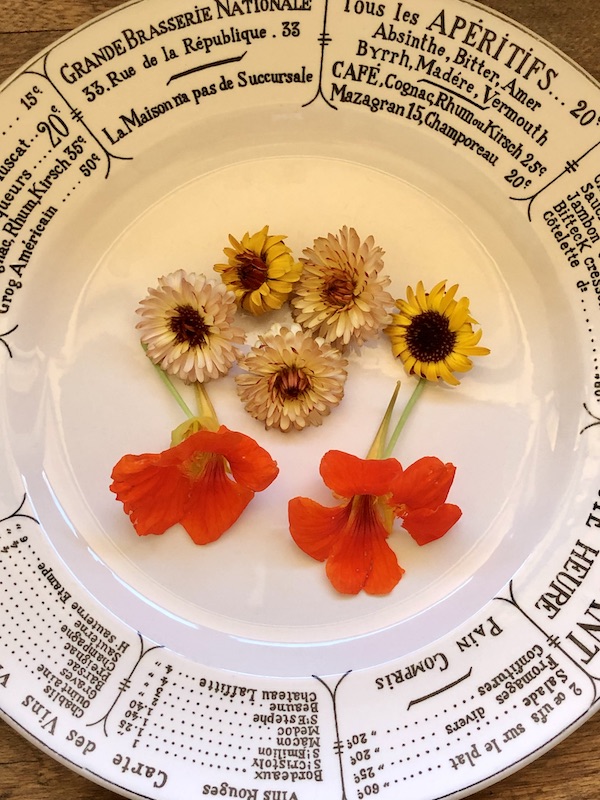
Flowers, Herbs & Vegetables
I give my chickens greens from my garden daily, including spinach, Swiss chard and lettuce. Other vegetables they love include tomatoes, pumpkin, and broccoli. (Do NOT give them avocados as they contain a component known as persin, which is lethal to chickens). In the spring, I forage my farm for wild miner’s lettuce and dandelion greens which they absolutely love to eat. Herbs are also provided from time to time, including basil, mint and oregano. Flowers such as nasturtium, calendula are also good for healthy eggs. Did you know that oregano can help prevent disease in chickens? Studies show that using oregano as well as garlic can help eliminate the need for artificial antibiotics. But if giving chickens garlic, be aware that it can affect the taste of your eggs.
Grains
I only feed my chickens organic chicken feed that has good nutritional value. Other grains you can provide include oats, barley, millet, flax, rye, and sunflower seeds. If you soak the seeds for 1-4 days they will ferment and this will add probiotics to help protect against harmful bacteria such as salmonella and E-coli. I also give my chickens foraged wild grasses which they enjoy scratching and pecking at to get the grain.
Fruits
Healthy fruits for chickens include watermelon, cantelope, cherries, berries and the like.
Calcium
Calcium is necessary to keep both the chickens and the eggs healthy. If you don’t feed them enough calcium, you will notice that the shells on your eggs are thin and flimsy. This can lead to breakage. I prefer to give my chickens oyster shells which you can purchase at most feed stores or online. You can also give them ground up eggshells, but I don’t recommend this as it could lead to the chickens pecking at their own eggs if they are looking for more calcium. A chance not worth taking, because eating their own eggs is a very hard habit to get rid of.
Providing your chickens with a healthy and varied diet will provide you with the healthiest eggs ever. Try to avoid giving them table scraps or foods with little nutritional value. And never give them food that is rotting or spoiled. To find out more about what not to feed your chickens, see 15 Things You Should Avoid Feeding Your Chickens.
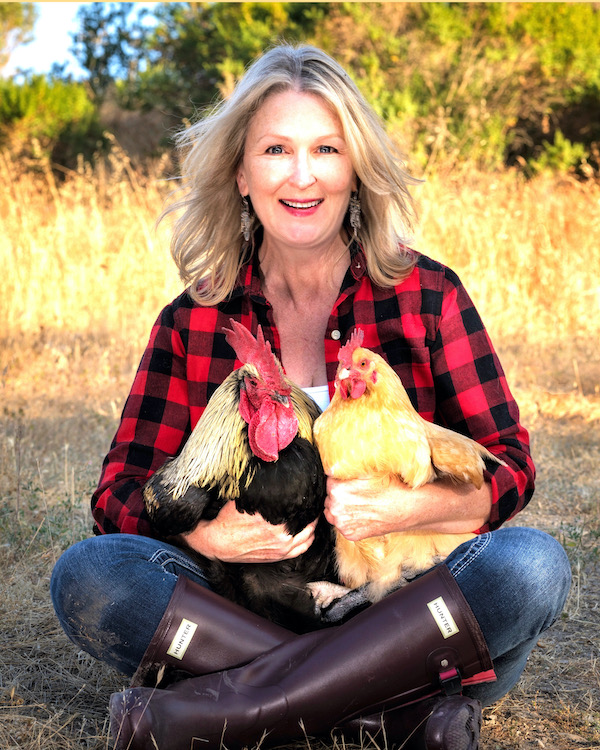
Thank you for visiting my blog! Wishing you peace, love, happiness, and healthy chickens and eggs.
-
Holiday Charm in Carmel by the Sea

Twinkling lights, evergreen wreaths and festive ribbons bedeck the doors and windows in lovely Carmel-by-the-Sea, heralding the holiday season. These are just the icing on this fairytale city, filled with storybook homes, unique shops, world-class restaurants, and even an old-fashioned newspaper, The Carmel Pine Cone. None of the homes here have addresses, but instead unique, homespun names.
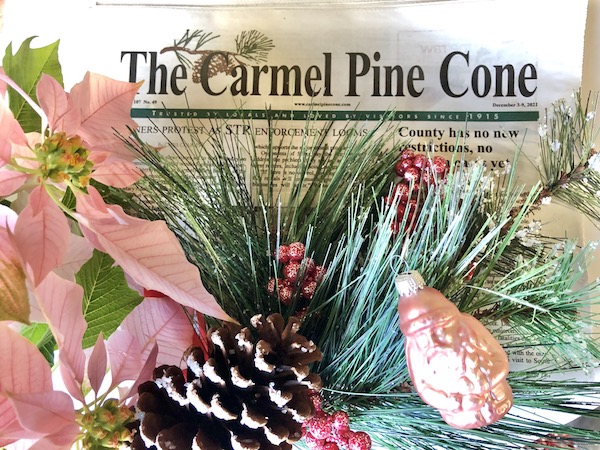
The current issue of Carmel’s newspaper, The Carmel Pine Cone. Welcome December! Traveling down the streets of Carmel, you are greeted with colorful flowers and lovely holiday decor.


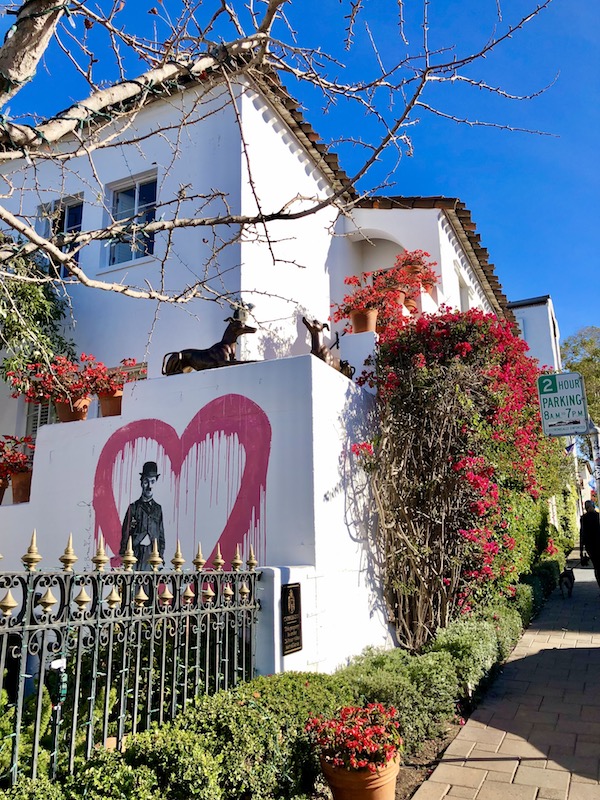
The average daily temperature here in December is 60 degrees, making it the perfect time to stroll around town and admire the lovely sights.

Make sure to wear comfortable walking shoes while you are here. And do not wear high heels! They are prohibited by a city ordinance. With all the uneven stone walkways and pavements here, it is easy to understand why. Nonetheless, if you must wear heels, you can purchase a high heel waiver at City Hall. You may find it interesting to know that ce cream was previously prohibited because it was deemed too messy, creating unsightly walkways. Thank goodness that ordinance was repealed!
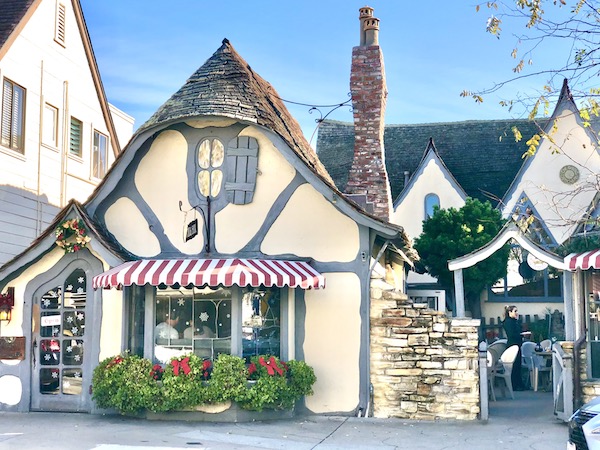
Of course, if you are in Carmel for the holidays, you simply must check out some of the quirky storybook buildings created by former Carmel resident and builder, Hugh Comstock. The Tuck Box, shown above, is one of his most famous creations.
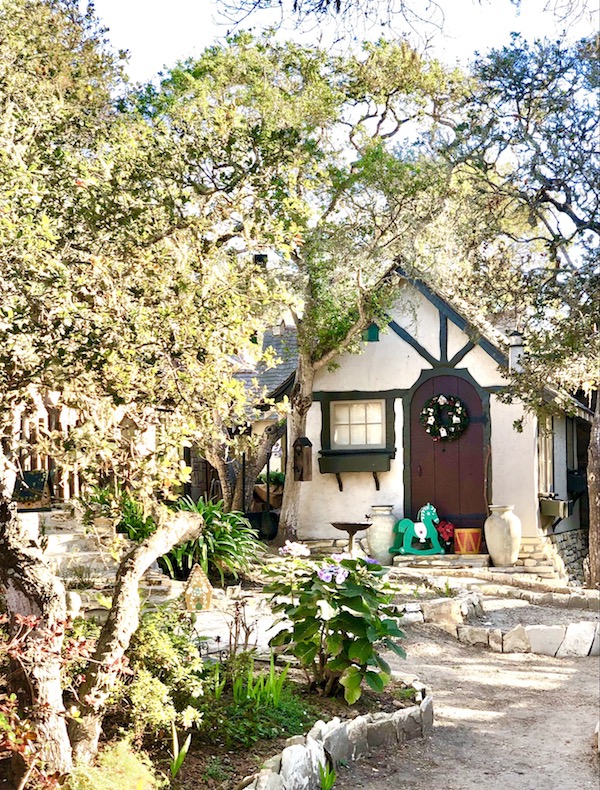
The Gretel Cottage, above, is another home built by Comstock. It was recently revealed, along with the nearby Hansel Cottage, following a long renovation. Gretel is dolled up and ready for the holidays!
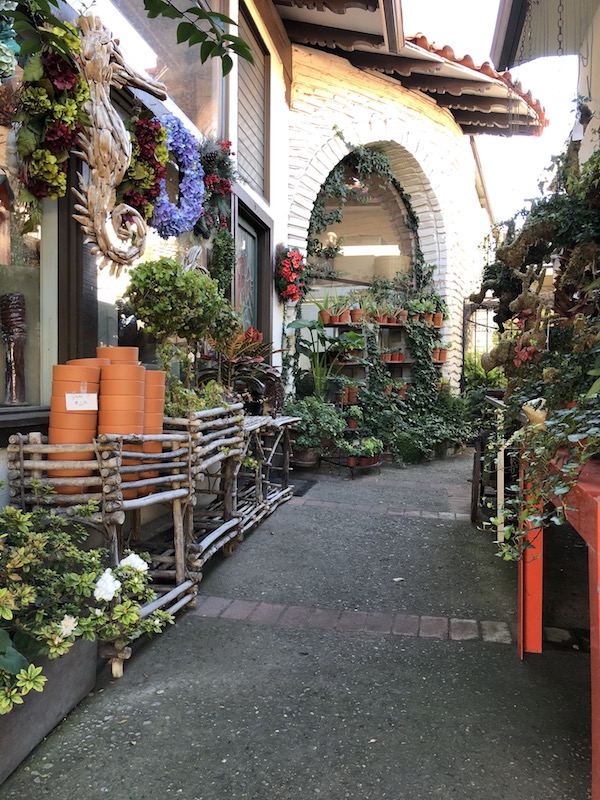
One of the best things about Carmel is discovering all the secret passageways as you walk the streets. You never know what you will find hidden around the corner!
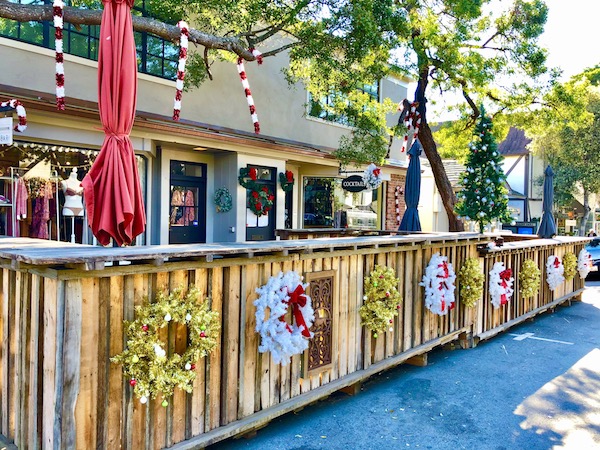

Nearly all the restaurants here feature outdoor as well as indoor dining. And nothing is cozier than sitting near a warm heater while enjoying your meal in the fresh seaside air.
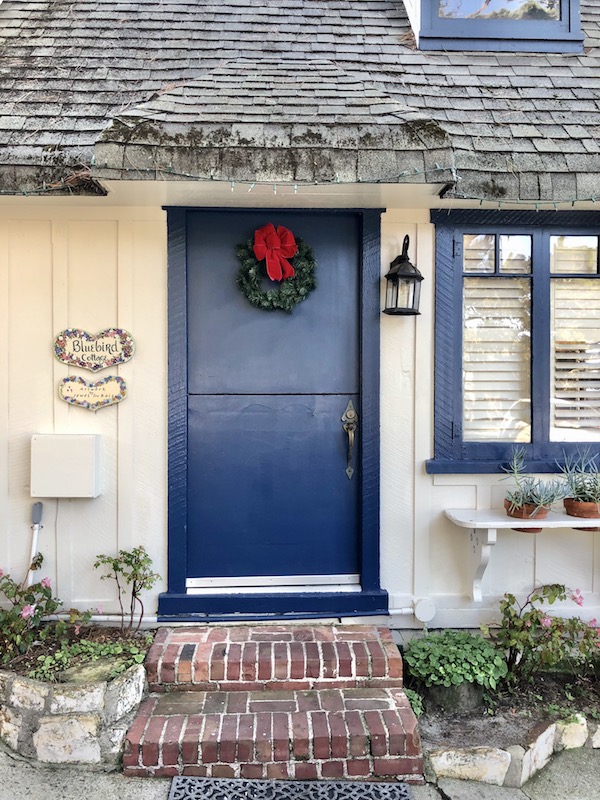

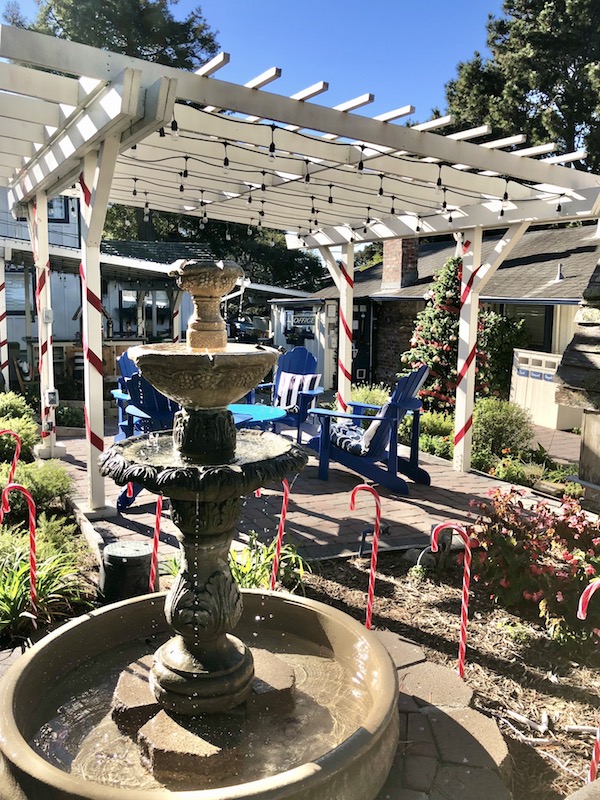
Thank you for visiting my blog. I hope you enjoyed viewing the holiday decor in Carmel. Most of my photos were taken just today! It was beautiful, sunny, and the most perfect December Sunday anyone could hope for. You may also like The #1 Guide for What to See and Do in Romantic Carmel and Fairy Tale Cottages in Carmel-by-the-Sea. Wishing you peace, love, happiness and the happiest of holidays!
-
Trick or Treat, It’s Halloween!

Halloween has arrived here in Monterey County. When I was little and living in the Midwest, Halloween was one of the most important holidays. Why? It meant dressing up in costumes and going trick or treating for candy. There was nothing better than arriving home and dumping our bags of goodies on the floor, where we would meticulously poke through it all and discard the yucky ones or trade them for something better. There were also costume contests and parades at school, and bobbing for apples, hayrides, bonfires, and other fun activities that we kids just loved.
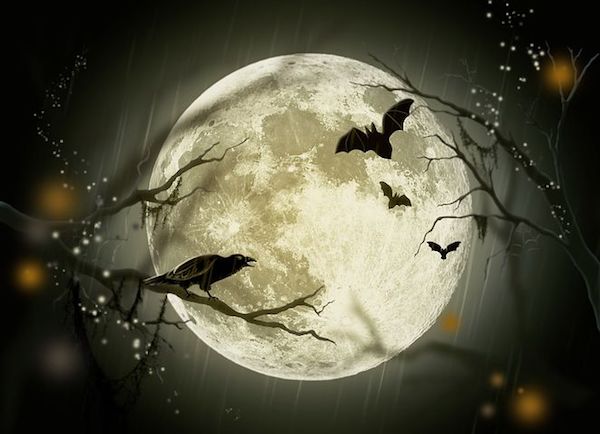
Historically, Halloween has its origins in Samhain, a festival celebrated by the ancient Celts. It was a time of bonfires and wearing disguises to protect oneself when the spirits of the dead revisited the earth. It is thought that trick or treating originated around this time. Guising, or mumming, involved dressing up in costumes and singing, playing card tricks, or telling stories in exchange for sweets. Trick or treating as a tradition did not become popular in the United States until around the 1920s. The demand for a treat meant that no trickery would befall the giver, including soap on their windows.
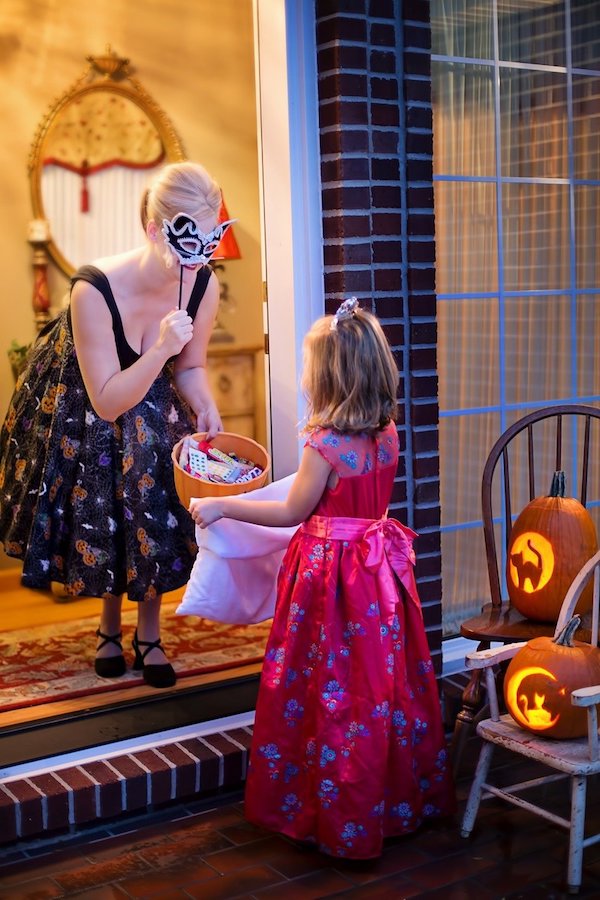
While I no longer go trick or treating, and can’t give out candy because I live in the country, I still enjoy all the other fun fall activities surrounding this day. One of my favorite things about Halloween is seeing all the festive decor people use to decorate their homes. From happy pumpkins to spooky ghouls, I just love seeing all the creative ways people show their Halloween enthusiasm.
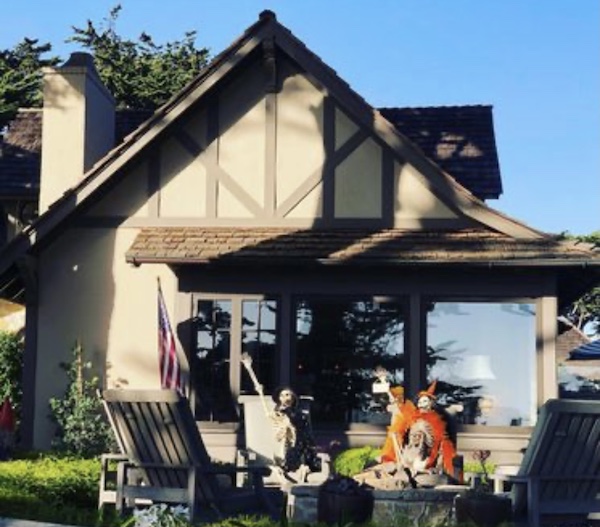
A seaside home in Carmel featuring friendly skeletons. 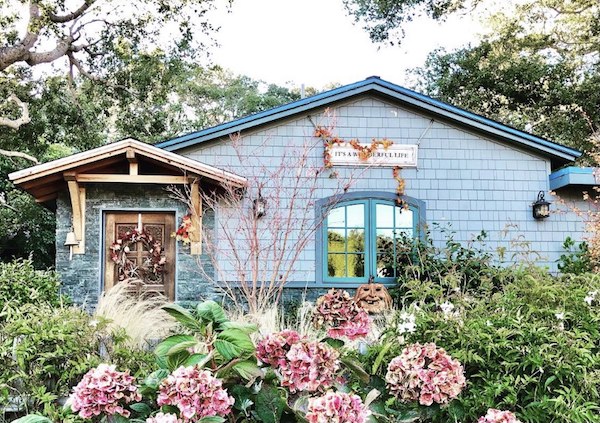
Another festive home in Carmel-by-the-Sea. 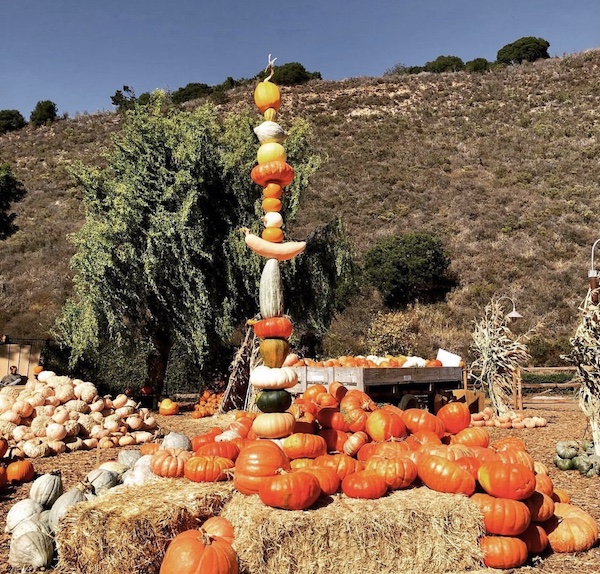
A tower of pumpkins and squash looks simply gourd-geous at the local pumpkin patch. What are your favorite Halloween memories? Do you still dress up in a costume or hand out candy? Or do you like to decorate inside or outside your home? It’s hard not to feel excitement at this magical time of year, with the exception of my cat Georgie, below.
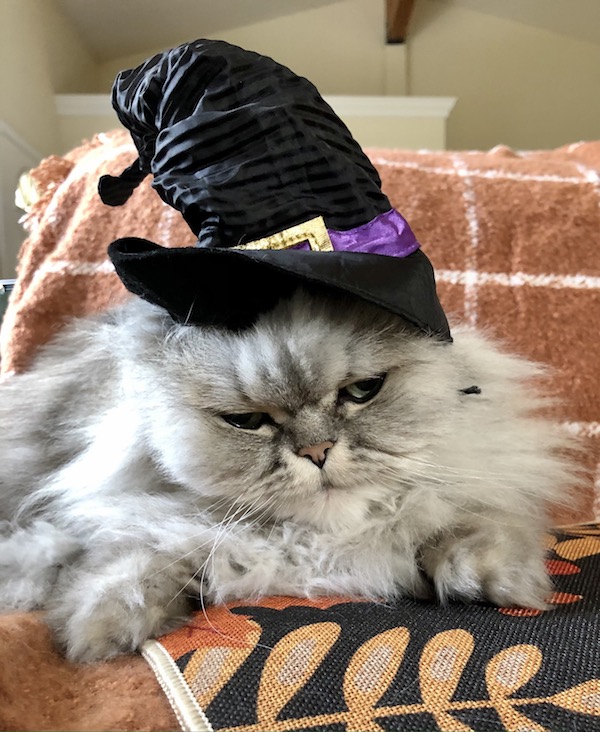
Georgie, my cat, is not feeling very festive in his Halloween costume. Thank you for visiting my blog. I hope you have a very safe and happy Halloween. For more information on Halloween traditions, see Trick or Treating. You may also enjoy The Eight Most Haunted Places Near Monterey. Wishing you peace, love, happiness, and beautiful vistas.
-
The 8 Most Fantastic Rare Pumpkins
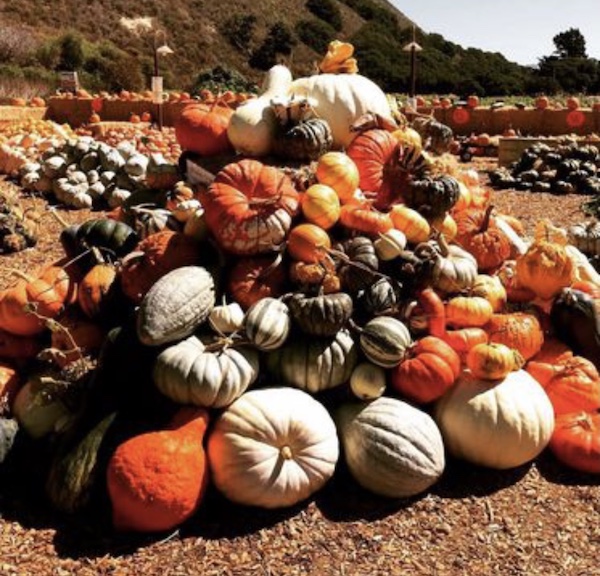
Back in the day, visiting the pumpkin patch was simple because there were not many choices. As long as it was round, orange, and capable of being carved into a jack-o-lantern it did the trick. Today we have so many more varieties available, including rare heirloom pumpkins. It’s so exciting to see all the new choices. You can’t help but fall in love with these beauties. Here is my list of the 8 most fantastic rare pumpkins!
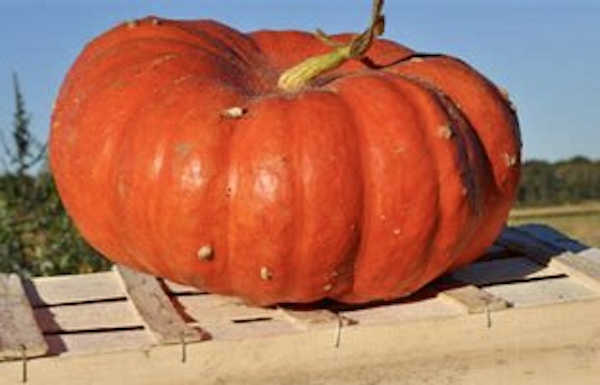
1. Rouge Vif D’Etampes, also known the Cinderella pumpkin, was supposedly the most popular pumpkin in Parisian markets of the 1880s. It’s vivid red color makes it perfect for autumn displays. It is also quite tasty, and is a standard for French soup stocks.

2. Speckled Hound features a pale pink color splotched with blue green. I love the name and the color combination. It is also edible!
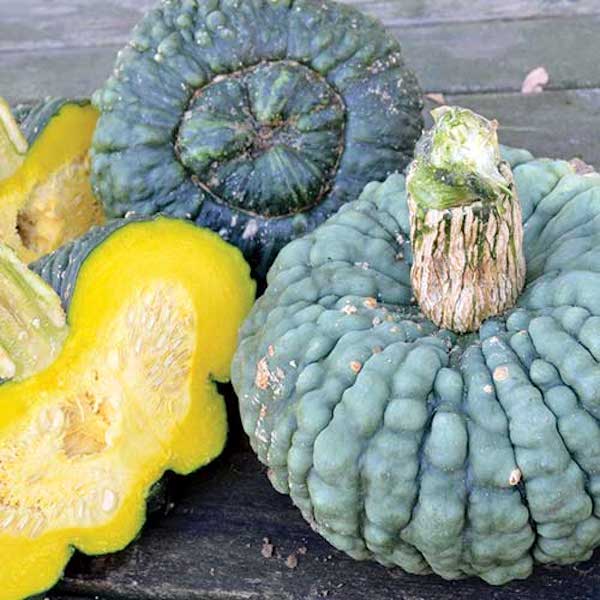
3. Zucca Barucca, also known as Marina de Chioggia, as well as “Holy” and “Sea” pumpkin, features bumpy green skin . It is said that the name may be derived from the Hebrew word for holy, “baruch” and that Jews fleeing the Spanish Inquisition brought them to Italy. It is also edible, with a silky, sweet flavor similar to butternut squash.

4. Lumina pumpkins are smooth and white on the outside and have delicious orange flesh within. Other white varieties include Ghost, Full Moon, Valencia, Silver Moon and Casper. White pumpkins were originally a mutation in classic orange pumpkins but are now much beloved for their ghostly hue.

5. Warty Goblin is a frightful, delightful variety that will charm you with its lumpy green bumps. Even though they look scary on the outside, they have a sweet and mild flavor that makes them good for roasting or baking.
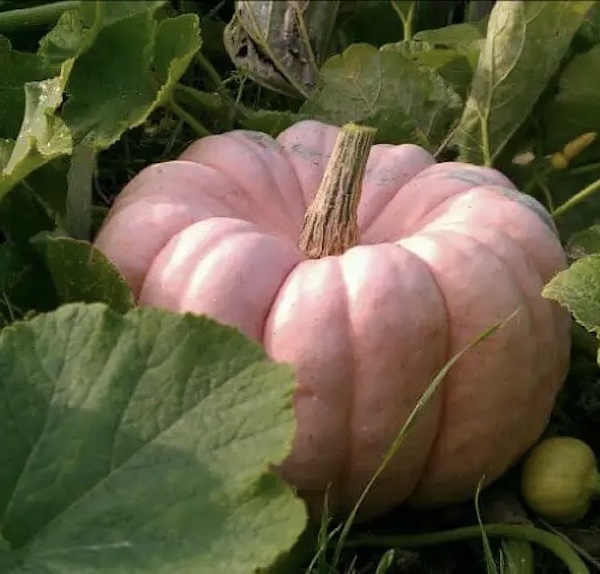
6. Porcelain Doll is a fantastic shade of pink. So unique! And it is also edible and perfect for pies, soups and other fall fare.
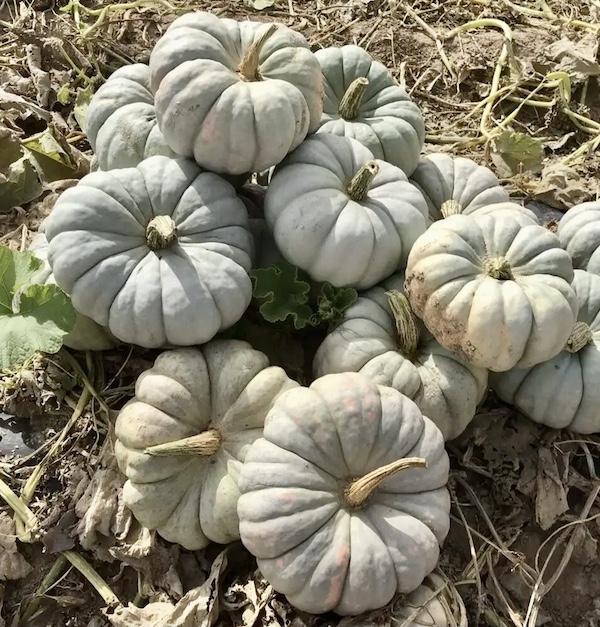
7. Mint Prince pumpkins feature a lovely mint shade and deep ribbing. These have a flat shape that make them perfect for stacking. They are also good for baking, with smooth, creamy flesh.
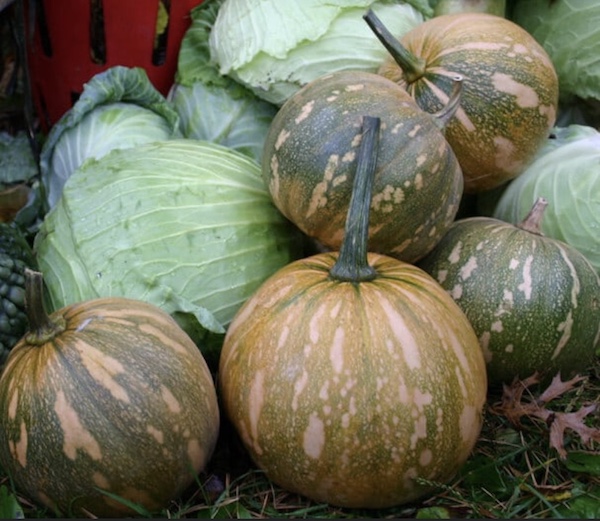
8. La Estrella hails from sunny Florida and features subtle orange skin splashed with soft green and tan blotches. Is it edible? You bet!

Thank you for visiting my blog! You may also enjoy Fifteen Fabulous Pumpkin Designs For Halloween and Sugar & Spice: My Favorite Fall Flavors. Wishing you peace, love, happiness, & beautiful vistas.
-
Sensational Sunflowers: Fun Facts You May Not Know!
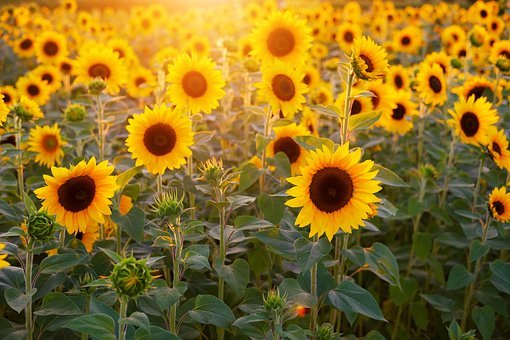
Have you ever looked at a field of sunflowers and just smiled? Something about their bright, cheerful colors just makes you happy. In fact, the sunflower is a symbol of positivity. There is so much more to these blooms than just their prettiness, though. Here are some fun facts about sunflowers you may not know.
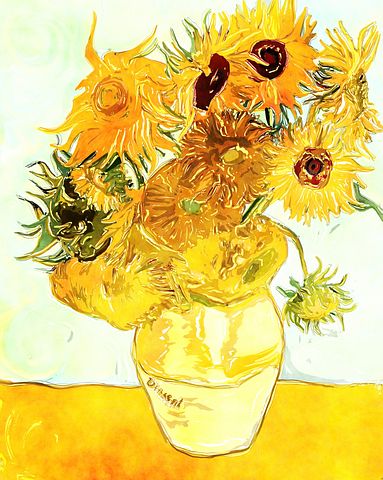
The scientific name for sunflower is Helianthus. This comes from the Greek word helios (sun) and anthos (flower). They are native to America and there are at least 70 known species. It is said that Native Americans cultivated sunflowers, possibly even before they grew corn. The artist Vincent Van Gogh was so enamored with them he devoted an entire series of paintings to them.
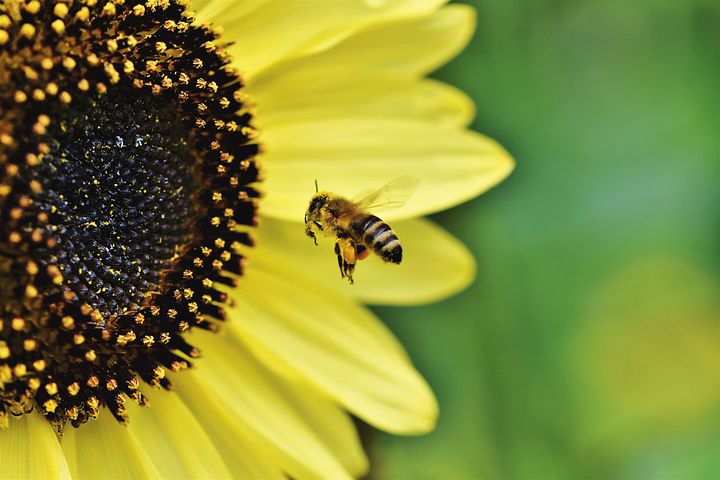
Sunflowers can grow up to 12 feet tall, but require full sun and well-drained soil to reach their optimal height. In 2014, a sunflower in Germany broke the world record at a whopping 30 feet, one inch! They are the state flower of Kansas and the national flower of Ukraine. The center of the sunflower attracts bees, but they are actually self-pollinating.
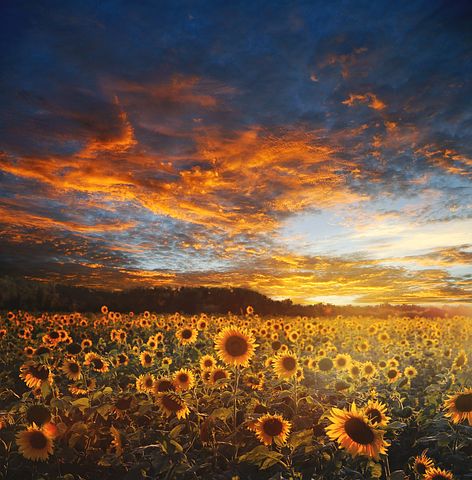
Sunflowers have a very unique feature called heliotropism which starts as they begin to bud. Almost magically, the sunflowers face the sun at all times, from early in the morning when the sun rises in the east until sunset when it sets in the west. The French call sunflowers tournesols, meaning “turned sun”, to describe this behavior.
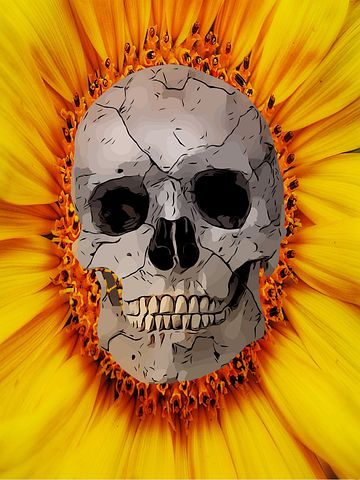
Some people, like me, love sunflowers, but for some people they are scary. I was once acquainted with a well-known photographer who was frightened by sunflowers. The scientific name for the fear of sunflowers is helianthophobia.
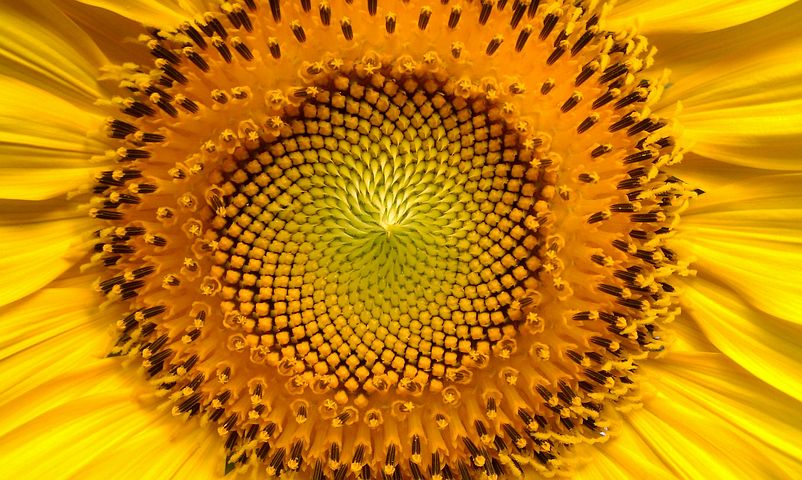
Sunflowers are also a perfect example of the Fibonacci sequence. This process involves a special number called the divine proportion, or golden ratio, for its widespread presence in nature. It’s amazing to think of all the symmetry and order that occurs in our world as the result of this! To understand the Fibonacci sequence, check out the video, “Nature by Numbers”, by Cristobal Vila.
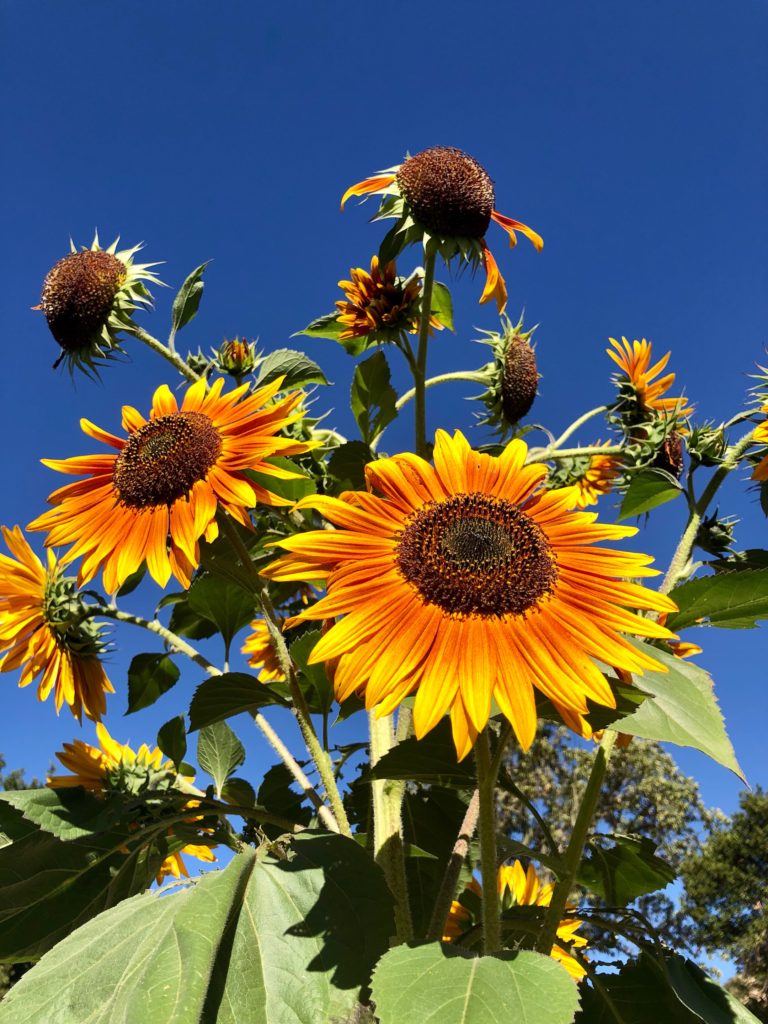
Sunflowers growing on my farm. Thank you for visiting my blog. You may also enjoy Flowers & Other Stories: Spring Gardens I Love and What the Color of Your Flowers Says About You. Wishing you peace, love, happiness and beautiful vistas!
-
Simple Tips For Making Homemade Soy Candles
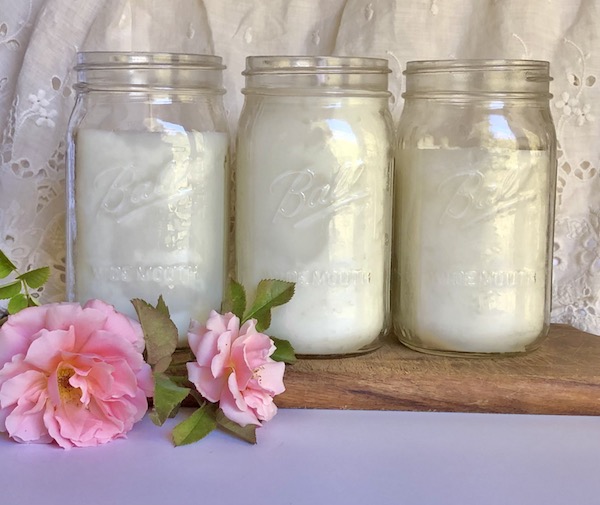
Natural handmade candles are beautiful but also can be quite expensive. I decided to make my own. This was my first experience making candles, so I am going to share things I did wrong, or learned, to help you if you want to make candles. Why did I want to make candles? I just love the ambiance candlelight offers and I also wanted to create my own scents using essential oils. Using soy also made me feel more comfortable since it is organic and more eco-friendly than other materials. Also, with unexpected power outages here in California, candles come in quite handy.
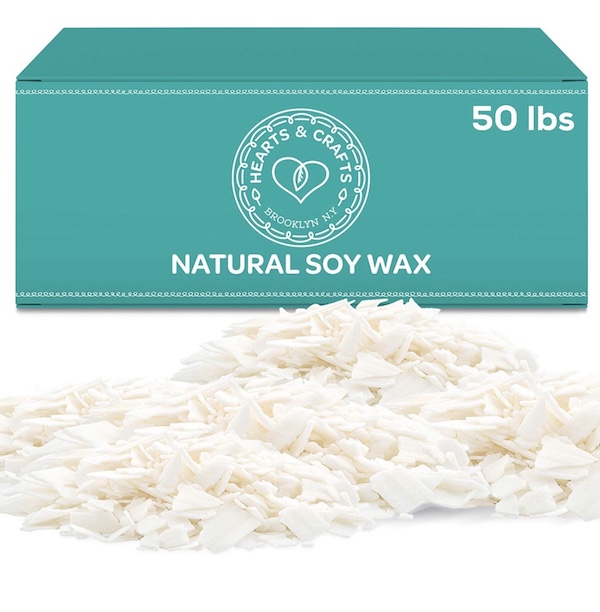

This is what I used. I ordered both on Amazon. The canning jars are leftovers from when I canned plums. Other items you will need include a large pan filled halfway with water, a smaller container such as a large measuring cup that will fit inside the larger pan, and a candy or candle thermometer.
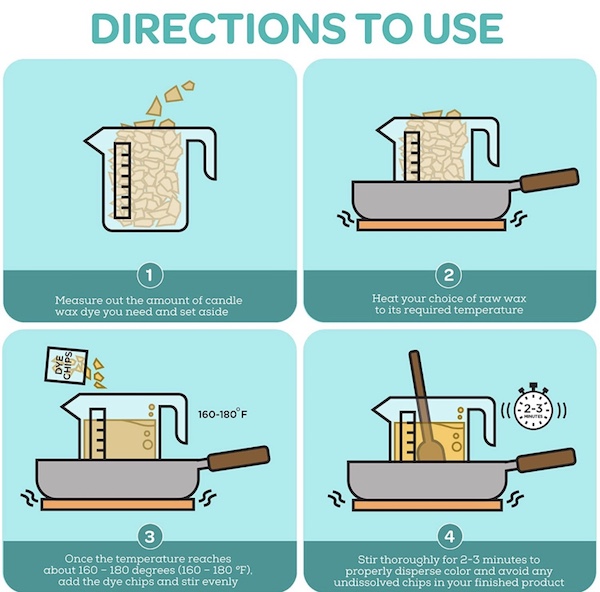
It was great that they included very clear directions with pictures (even though I did not use any dye). If you choose to use dye, be aware that normal food coloring will not work–you have to use oil-based dyes. Once the wax is melted, you can add your scent or essential oil.
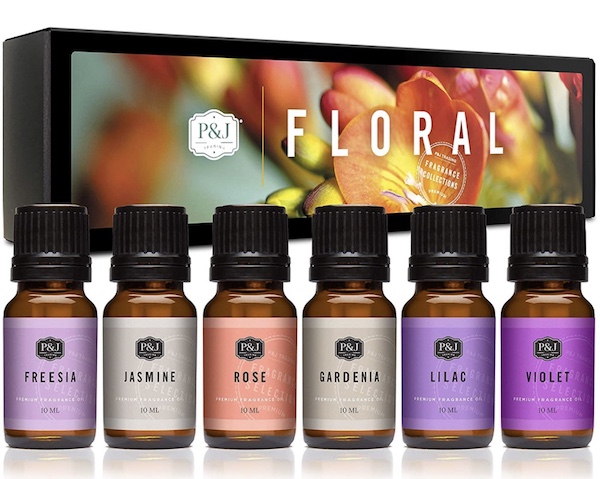
I used floral essential oil scents for my candles including jasmine, rose, freesia, gardenia and lilac.
Helpful Tips I Learned:
- The wax flakes will cook down, down, down and often you only have 1/2 to 2/3 of what you originally measured so plan on adding a bit more than you need at the beginning to avoid this.
- When you add a bit of wax on the bottom of your wick and stick it to the bottom of the jar, wait at least 15-20 minutes for it to dry before pouring your melted wax in. I didn’t wait long enough for my first two candles and the wicks moved away from the center. I had a heck of a time getting them in the center again.
- Know how tall your mason jars will be before you order your wicks. When I ordered my wicks several months ago, I had planned on using short canning jars but then ended up using the tall ones. I only had 6 inch wicks so I tied yarn to the top of the wick and draped it over each side to hold the wick in place.
- Make sure to not add too much essential oil because it can be flammable, I added about 15 drops to each quart jar.
- Use something old or that you can throw away to stir your wax, like an old spoon. I used a wooden spoon but then found that a wooden chopstick left over from Chinese takeout worked just fine.
- The last part of the melting seems like it lasts forever! There are several little chunks that you think will never melt, but hang in there.
- It takes approximately 12 hours for the candles to solidify.
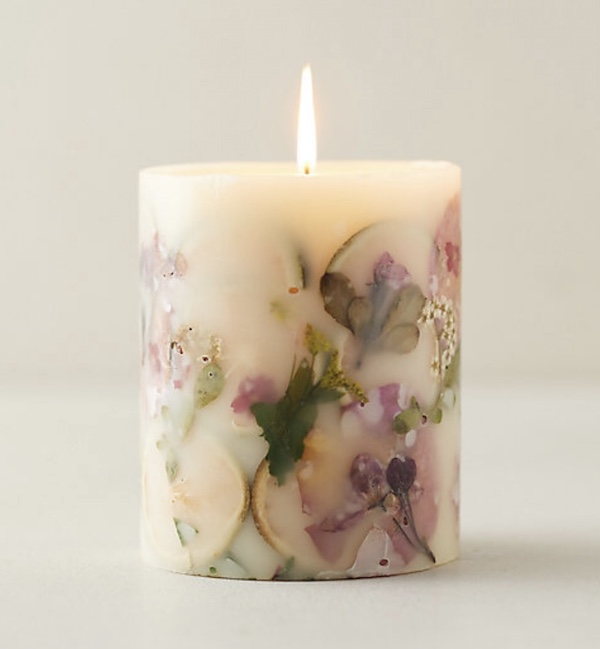
Next on my candle making list: using pressed flowers like this beautiful candle from terrain.com The next time I make candles I am going to try using pressed flowers on the sides to add a bit of prettiness. I love the look of these. Or maybe I will create some cute paper labels to put on the outside. Or add some twine and cinnamon sticks and give some as Christmas gifts.
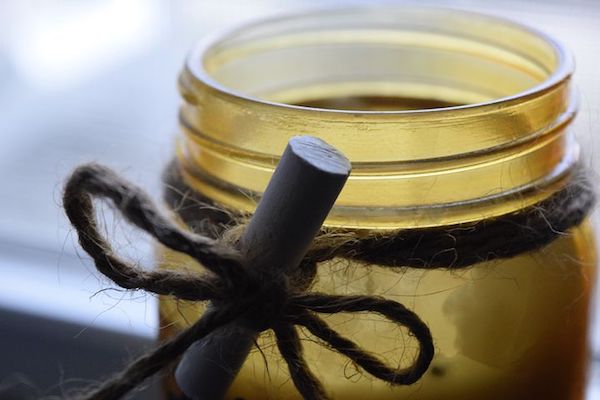
Thank you for visiting my blog! You may also enjoy Don’t Sweat That Unfinished Baby Book and Get Super Healthy Hair With Herbal Vinegar! Wishing you peace, love, happiness & beautiful vistas.
-
The Prettiest Hidden Homes of Carmel
Houses, like people, have different personalities. Some are bright and bubbly and just exude charisma. They stand out and seem to get all the attention. Others are quiet, shy, and like to stay out of the limelight. Sometimes they like to remain hidden for privacy, and other times they have been been ignored or simply overlooked. Join me as I explore the prettiest hidden homes of Carmel.
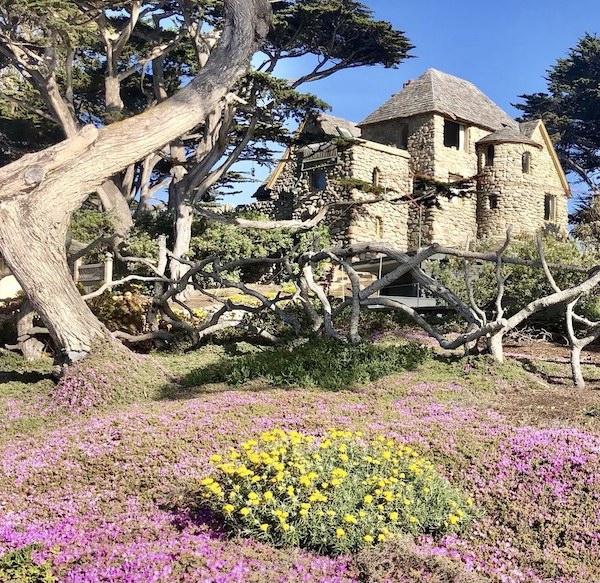
Kuster Castle
The Kuster house, sometimes called Kuster Castle, sits high on a hill on Ocean View Avenue. It is somewhat hidden behind greenery and a fence made of tree branches. It was built in 1920 by Edward Kuster, an attorney, who moved to Carmel and eventually built the Golden Bough Playhouse. Kuster’s move was considered scandalous at the time because he was the ex-husband of Una Jeffers, now wife of famous poet Robinson Jeffers. So what did Mr. Kuster do, but build his house next to the Jeffer’s Tor House! Apparently, both couples got along extremely well. Una even did her laundry at the Kuster’s because Tor House had no electricity.
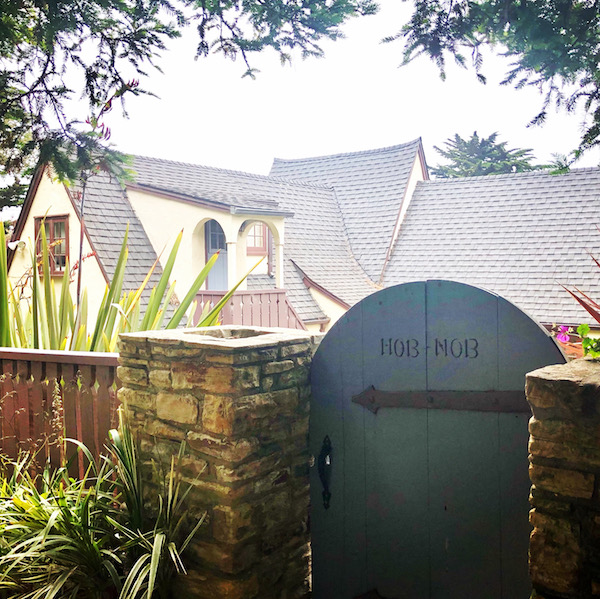
Hob Nob Cottage
Hob Nob Cottage is easy to overlook. Because the gate is rather dark and the house below the road, it remains somewhat hidden from view.

Built in 1924, this Tudor Revival home was originally known as the Garfield D. Mermer house. The origin of its current name is interesting. Hob and nob first came together in Shakespeare’s Twelfth Night, when Sir Toby Belch warns Viola (who is disguised as a man) that Sir Andrew wants to duel. “Hob, nob is his word,” says Sir Toby, using hob and nob to mean something like “hit or miss”. Since that time, hob and nob became a phrase meaning friends drinking hobnob to each other, and from there it became associated with congenial social gatherings.
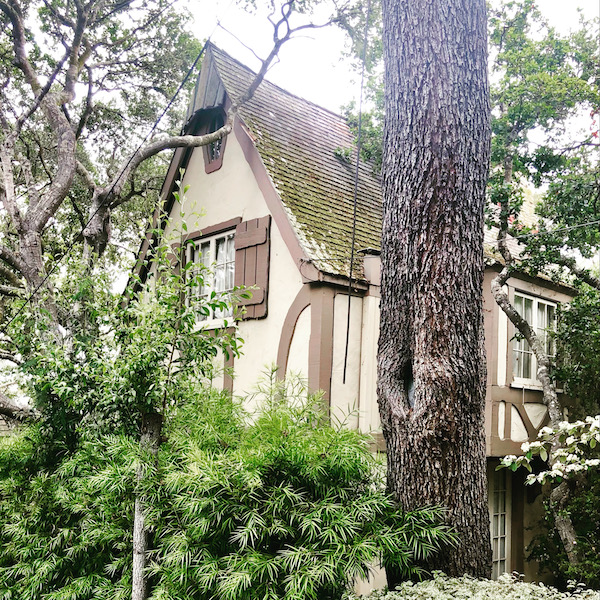
Birthday Cottage
It took some clever camera finagling to get a proper glimpse of the Birthday Cottage. This one really tugs at your storybook heartstrings with its steep storybook gables and half timbered walls. Unfortunately, most of the house is simply out of sight, hidden behind trees, shrubs, and foliage. I have not discovered the story behind the home’s name, but maybe it was a present for some lucky soul back in 1929 when it was built. Located at the corner of Santa Fe Street and Sixth Avenue, it was part of a complex of five homes commissioned by W. O. Swain and built by Hugh Comstock.

Fables
Almost completely buried in a tapestry of vines and ivy, Fables is another hidden cottage. Fables is sandwiched between the Birthday House and the Doll’s House. Featuring a steeply pitched roof and Carmel stone chimney, Fables was built by Hugh Comstock in 1928.

The Doll’s House
Nobody ever seems to come play in this Doll’s House. Located next door to Fables on the corner of Santa Rita and Ocean Avenue, it appears to be empty. It too remains largely hidden from view by trees and shrubbery. This home was also built by Comstock in 1928.
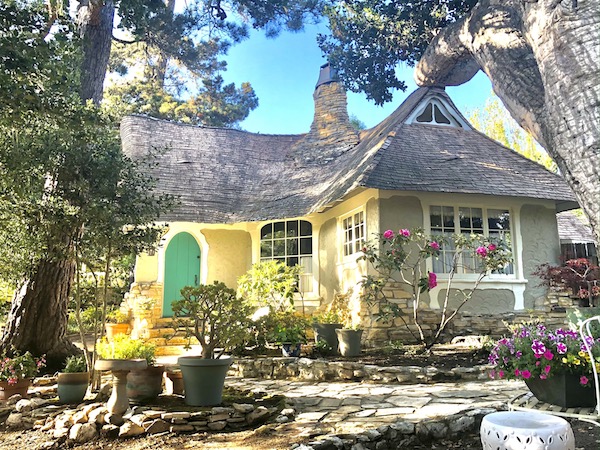
Märchen Haus
Märchen Haus is German for Fairytale House. Located at the corner of Dolores and 11th Street, it is several blocks away from many of the other other Comstock homes. It is also somewhat disguised by all the trees and shrubbery surrounding it. This house is clearly very loved and was getting a fresh coat of paint this past spring. The hand cut shingle roof and curved front door remind me of something from Goldilocks and the Three Bears. This home was also built by Comstock in 1928, which was clearly a busy year for him.
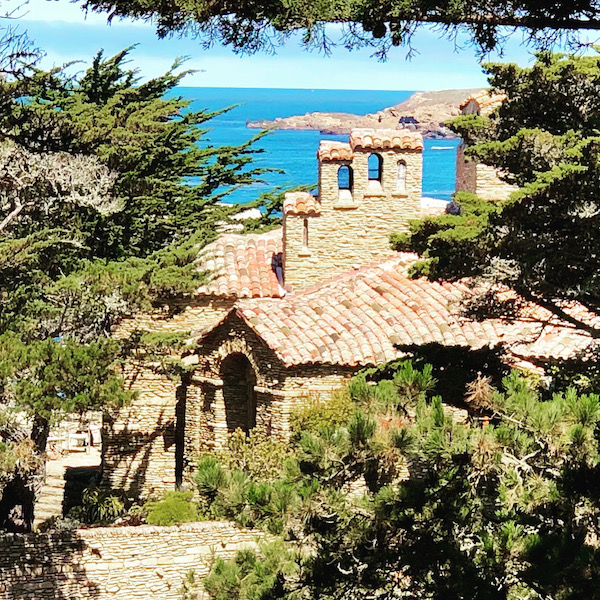
Seaward
At the edge of a cliff overlooking the ocean, “Seaward” lies just south of Carmel-by-the-Sea in the Carmel Highlands. If you are lucky, you may catch a glimpse of it, hidden behind a high stone wall and a forest of cypress trees. Designed by Charles Sumner Greene and built in the 1920s for D. L. James, it seems to naturally grow straight out of the cliff. If you look closely, you will see all the tiny stones making up the beautiful architecture. I can’t fathom how many people or hours it took to build this iconic home.

I hope you enjoyed taking a peek at the prettiest hidden homes of Carmel. You may also like 12 Storybook Cottages to Enchant You! and Cottage Love in Carmel-by-the-Sea. Thank you for visiting my blog! Wishing you peace, love, happiness, and beautiful vistas.
-
The Stunning Storybook Homes of Willow Glen

Willow Glen
Willow Glen is often called San Jose’s local treasure. Not only does it have a historic downtown full of fabulous shops and restaurants, but also the most enchanting storybook homes. I had already checked out San Jose’s storybook homes near the Municipal Rose Garden. I was so excited to discover more in Willow Glen.

Storybook Homes
What is a storybook home? Storybook architecture was created in the Los Angeles area during the 1920s. Storybook homes often have deeply sloped or thatched roofs. They may also have turrets and dovecotes, arched doors and windows, and eyebrow dormers. They are often made of stucco, brick and half-timbering.

Often featuring crooked walls, rustic chimneys, and sometimes cartoonish features, storybook homes soon became the rage across the country.
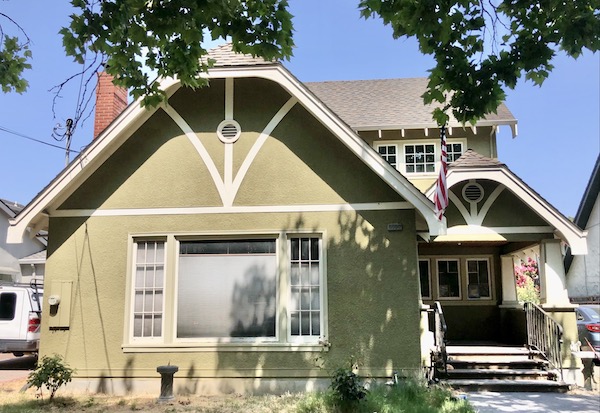
While most of the homes near the Municipal Rose Garden are from the same period, I found that in Willow Glen, the storybook homes are interspersed with both older and newer homes.

I just love the quaint chimney and the asymmetrical gable on the entryway of this home!

I never tire of seeing the lovely gardens and especially the roses in the San Jose area!
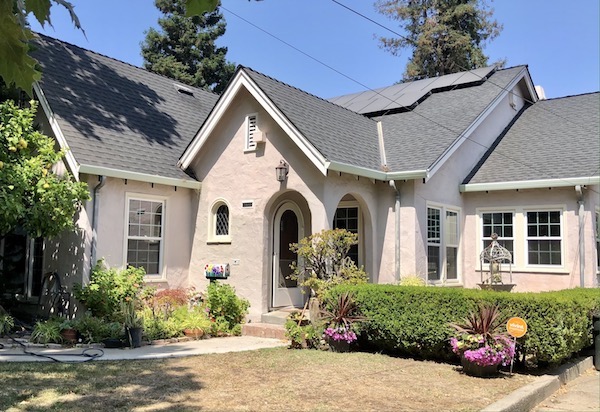

Fun facts about Willow Glen
- During the 1800s there was a marshy area between the Guadalupe River and Los Gatos Creek. Filled with willows and cattails, it inspired the name Willow Glen.
- Before becoming a town, Willow Glen was one of the most prized and valuable farming areas in the Sant Clara Valley.
- Willow Glen Road was renamed Lincoln Avenue in 1865, shortly after President Abraham Lincoln was assassinated.
- The area became incorporated as a city in 1927 to avoid the rerouting of the Southern Pacific Railroad down Lincoln Avenue. (Caltrain uses the track rerouted to a different area today.)
- Willow Glen residents voted to be annexed to San Jose in 1936 primarily to join the bigger city’s stage system and avoid having to build their own.
- During the Christmas season, many locals display small, multi-colored light Christmas trees in their front yards, a tradition that started in 1950.
- Today, Willow Glen is one of the most expensive places to live in Silicon Valley. According to trulia.com, the typical home value here is over one million dollars.
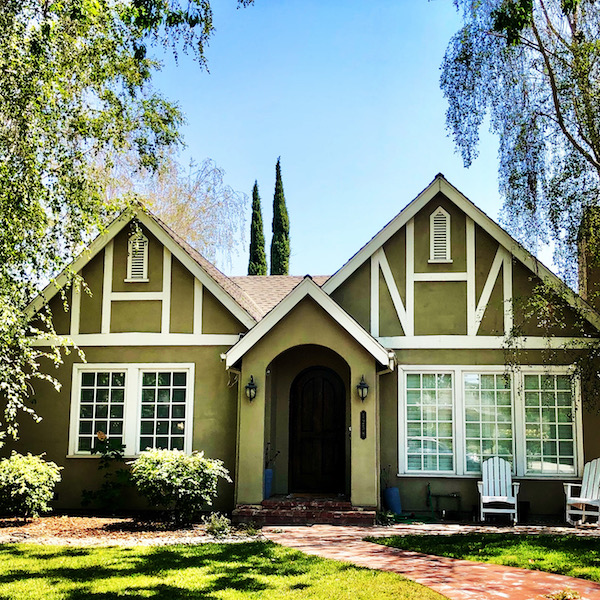
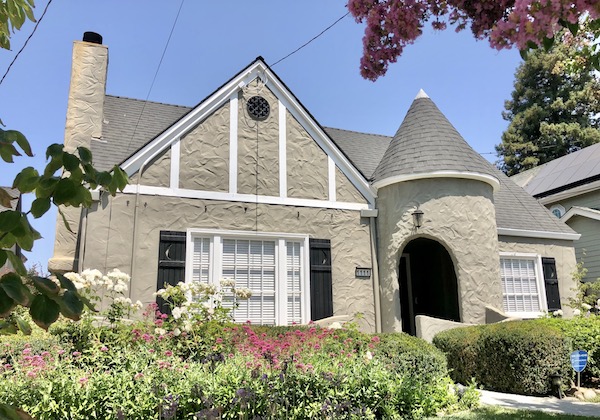
For more information, see Willow Glen. Thank you for visiting my blog! You may also enjoy Cottage Love in Carmel-by-the-Sea and 12 Storybook Cottages to Enchant You! Wishing you peace, love, happiness, and beautiful vistas!
-
My Pretty Shabby Chic Estate Sale Finds
What is shabby chic? Rachel Ashwell coined the phrase shabby chic. She has written several books about it and even has many videos online. Essentially, shabby chic is characterized by heirloom pieces with handcrafted accents and authentic distressing. Shabby chic decor also encompasses muted or pastel shades that provide a vintage feel. As Rachel states on her website, shabby chic embraces the beauty of imperfection. I see shabby chic as a marriage of country farmhouse comfort and romance. It is authentic and unpretentious. It certainly supports the cottagecore lifestyle with its cozy, inviting style. I often find beautiful shabby chic items at thrift stores and estate sales. Here are some of my favorite shabby chic finds. Everything I found was less than $5, with the exception of a frame I purchased for $15.
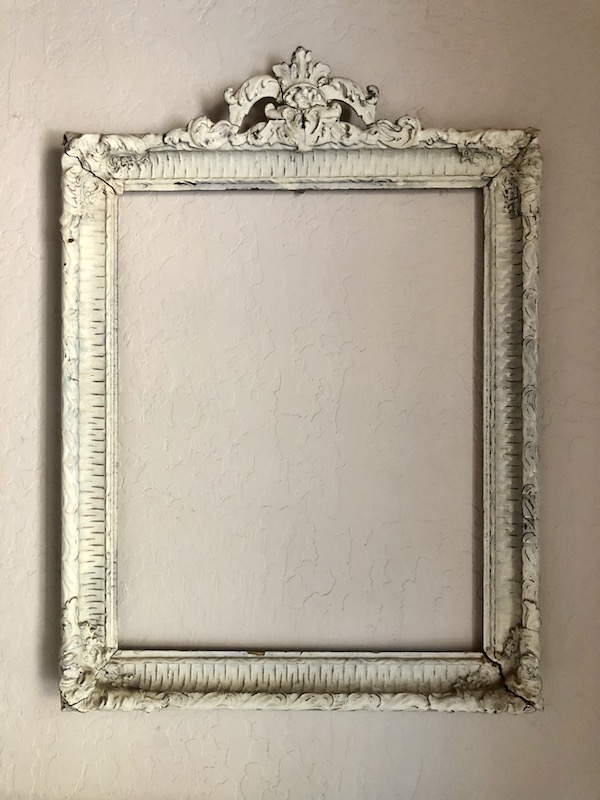
While I find many things shelter skelter, I hit the cornucopia recently at an estate sale in Salinas, California. I picked up this large 19 x 26 inch distressed antique French frame for $15. I am so stoked because I have never been able to afford the ones I found online. It is now hanging in my bedroom where I can adore it every day.
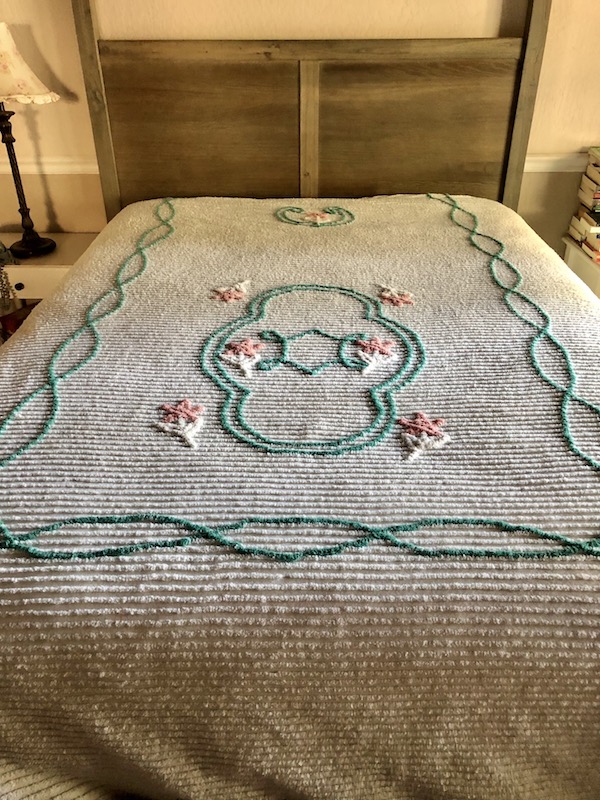
I found this vintage chenille bedspread for just $3 at Goodwill. It fits my queen bed perfectly and adds the perfect shabby chic vibe.

A beribboned wicker waste basket found at an estate sale for $5. So pretty!

Vintage lace crochet gloves for $1. Just makes me want to put them on and enjoy a nice cup of tea. I can also pay homage to one of my favorite icons, Ruth Bader Ginsberg, who rocked lace gloves like no other.
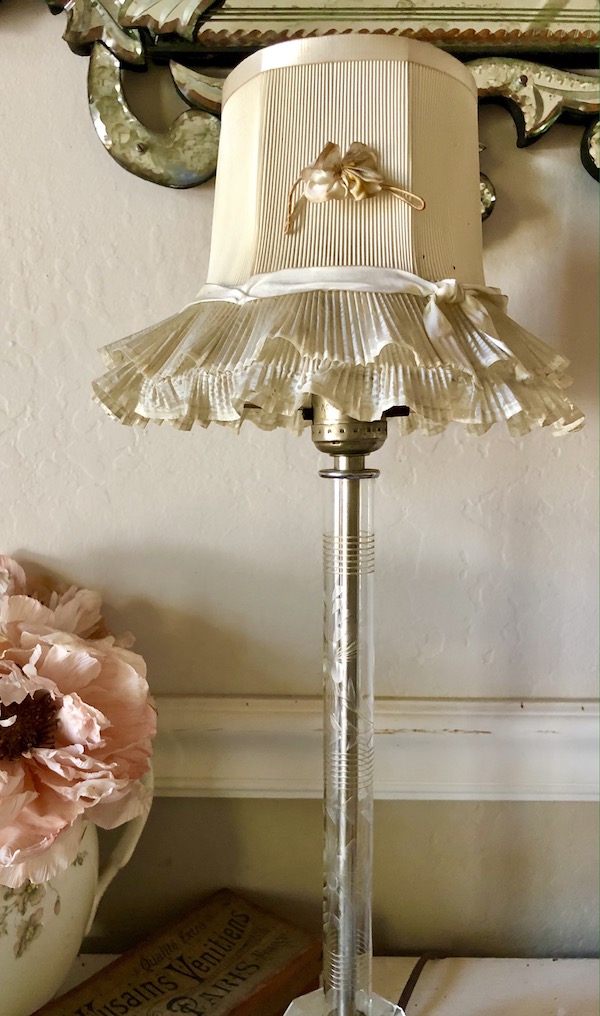
Vintage lamp with celluloid lampshade. So shabby chic, I love it!

A super cool hand-embroidered sewing fancy with pincushion and pocket for notions alongside an old wooden pair of glove stretchers. Both found at an estate sale for $3.
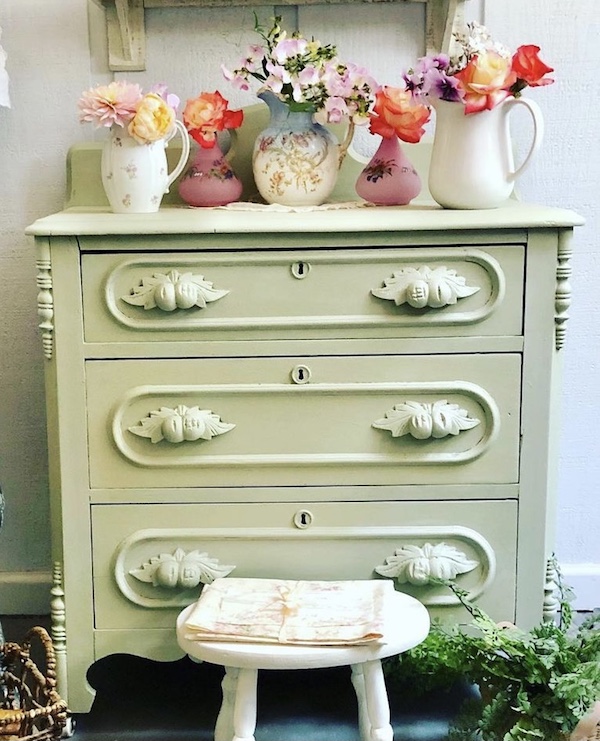
I found the little stool at a rummage sale for $3. The chest of drawers I purchased at an estate sale years ago. I repainted both using Miss Mustard Seed’s milk paint. Definitely adds a shabby chic vibe!

While this isn’t technically shabby chic, it is definitely vintage and spoke to me. Eloise Wilkin was a popular children’s book illustrator when I was growing up. The title certainly reflects my attitude. I am so grateful and thankful for everything in my life.

I hope you enjoyed seeing my recent finds. Thank you so much for visiting my blog. You may also enjoy The #1 Guide for What to See and Do in Romantic Carmel and Thrift Store Treasures: How to Find the Best Deals. Wishing you peace, love, happiness, and beautiful vistas!
-
How to Attract Hummingbirds To Your Home
If there were a bird olympics, hummingbirds would capture every gold medal. Hummingbirds are little miracles. They are superheroes in tiny bodies. They can flap their wings 80 times per second and can fly in all directions, including backwards and upside down. They can fly up to 30 miles per hour and up to 60 miles per hour in a dive. They are also smart, sweet, and sociable. I just love them.

Here on the farm, I wake up every morning not only to the crowing of my rooster, but also the whirring wings and cheery chatter of dozens of hummingbirds. I never tire of watching them at the feeders I have hanging outside my home. It is very easy to attract hummingbirds. Here are a few great tips that will entice these tiny wonders to your home.

Hang Hummingbird Feeders
Nectar is the primary food for hummingbirds and they need it almost continuously throughout the day. Nectar supplies fast energy to the hummingbird’s diet. The feeder should be where you can watch it, but also close to trees or shrubs where they can perch inbetween feeding. It should be in a shaded area to keep the nectar fresh longer. I have also found that my hummingbirds seem to be partial to one of the feeders I have that also has a perch around it so they can sit while they are consuming their nectar.
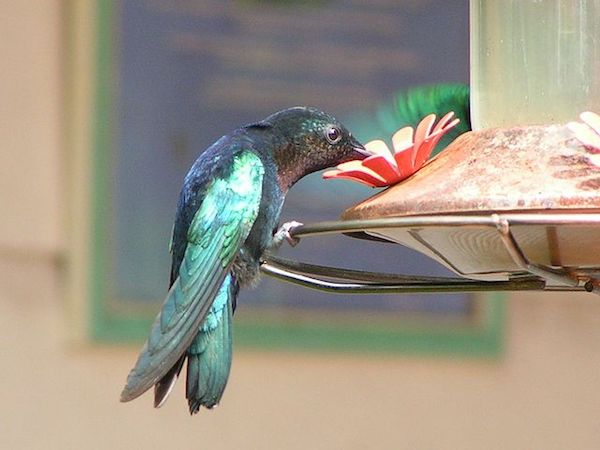
Use Easy Homemade Nectar in Your Feeder
Make your own easy organic nectar. Do not buy the stuff from the store with food coloring in it! While hummingbirds are attracted to the color red, the consequences of consuming red dye may pose potential health risks and is completely unnecessary.
Simple Nectar Recipe: Use 4 cups water and 1 cup sugar. Mix the two ingredients well and heat on stove until mixture comes to a boil. Boil 1-2 minutes. Remove from heat and cool before filling feeders. Never add anything but these two ingredients (and that includes artificial sweeteners and honey).

Keep Feeders Squeaky Clean
Clean your feeders well and regularly. Your nectar should last at least a week in the shade, but in cooler areas may last a bit longer. If it has been two weeks, whether they are empty or not, take them down and wash the shenanigans out of them. In particular, the little flowers over the feeding holes need to be cleaned carefully as they can build up toxic mold. I use bleach to clean mine and use chopsticks to clean the flowers. I then do a double and triple rinse to ensure all the bleach is removed. If you don’t feel comfortable using bleach because you don’t want to do all that rinsing, you can use 1 part vinegar and 4 parts water to clean your feeders. The primary goal is to kill all the toxic mold and bacteria.
Use More Than One Feeder For Best Results
To attract the most hummingbirds, try to have more than just one feeder, and place them at a distance. This will help prevent hummingbirds from fighting over food.

Plant Flowers That Attract Hummingbirds
Plant things around your home that hummingbirds love. Before I moved to my farm, I lived in a very small apartment. There were tons of bottlebrush trees behind it which were always filled with hummingbirds. Here at the farm, they love my hanging fuschia, petunias, plumbago flowers, zinnias, and also many of my succulent flowers. Other plants that attract hummingbirds are bee balm, honeysuckle, trumpet vine, cardinal flower, sage, rhododendron, columbine, butterfly bush, lupine, bleeding hearts, and any native red or orange tubular flowers.

Avoid Pesticides
Never use pesticides. Besides nectar from flowers, hummingbirds also eat spiders and other small insects.

Make Water Available
Hummingbirds are super clean and like to bathe frequently. Make water available via either a fountain or misting device. Hummingbirds also love sprinklers. Every time I turn mine on in the evening, I am guaranteed one or more of my little friends will come to play in the water.
Helpful Tips:
- Sugar/water nectar can be stored in the frig for up to 3 weeks.
- Use only feeders that are easy to clean. If you can’t reach inside or use a tool to get in and clean every nook and cranny, it is no bueno.
- Place feeders in areas where animals such as cats will be unable to reach them.
For more information on hummingbirds, see Audubon. You may also enjoy Add Charm to your Garden with Beautiful Birdhouses! and The Bluebird of Happiness. Thank you for visiting my blog. Wishing you peace, love, happiness, & beautiful vistas.